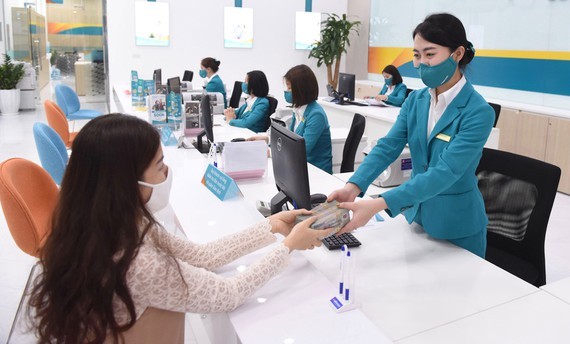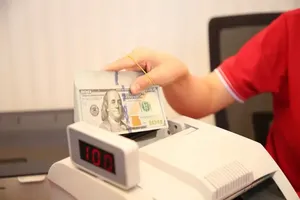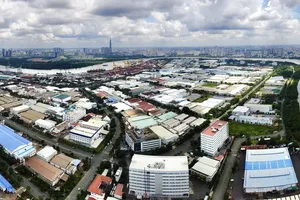 Some commercial banks increase their savings interest rates to compete with other investment channels. (Photo: SGGP)
Some commercial banks increase their savings interest rates to compete with other investment channels. (Photo: SGGP)
After a long period of cutting interest rates, from the beginning of March this year, some commercial banks, such as Techcombank, VPBank, and ACB, have started to raise deposit interest rates. However, in the market, the number of commercial banks reducing deposit interest rates is more, such as KienlongBank, PGBank, GPBank, and OCB. These lenders cut their deposit interest rates by 0.05-0.3 percentage points.
Many banking experts said that this conflicting interest rate change is only local. Some banks raise interest rates to increase the attractiveness of the deposit channel because other investment channels, such as stocks, bonds, and real estate, are fairly attractive. As for banks that reduce interest rates, they possibly had increased interest rates earlier to mobilize money for the capital needs during the Tet holiday, and now lower their interest rates due to low credit demand while liquidity remains abundant.
The fact that interest rates fluctuate in a small range is a very normal phenomenon and cannot be the basis for setting up a higher interest rate level. Mr. Nguyen Hoang Minh, Deputy Head of the State Bank of Vietnam (SBV) Ho Chi Minh City Branch, said that although some commercial banks had increased deposit interest rates, it was not the general trend of the market. The mobilizing interest rate level in the first two months of this year is still the same as that at the end of last year.
On the other hand, it must be admitted that although the number of banks raising deposit interest rates is small and currently has not put great pressure on the lending interest rate level in general. However, this will cause a certain pressure on the possibility of lowering the lending interest rates of other banks. Moreover, according to many experts, at present, the lending interest rates cannot be reduced following the savings interest rate because bad debts of banks are on the brink of increasing because they have to restructure and keep the debt group for customers affected by the Covid-19 pandemic. Profits are higher, but banks also have to set aside provisions. Therefore, the lending interest rates currently cannot be reduced in tandem with the deposit rates.
Many incentive packages
Besides cutting input interest rates to lower lending rates, commercial banks have entered the race to attract cheap capital from demand deposits. The interest rate of demand deposits is much lower than that of time deposits, only around 0.2 percent per annum. If the ratio of demand deposits is higher, it will help banks to increase their net interest margins and have more conditions to compete in terms of lending interest rates in the market.
To attract demand deposits, commercial banks have added more services and utilities to serve demand deposit customers. In the market, there are some commercial banks with the CASA ratio exceeding 45 percent, like Techcombank. Some other banks also have a high CASA ratio, including MBBank with 39 percent and Vietcombank with 30 percent. Many other commercial banks are trying to achieve increasing CASA ratio levels to reduce capital costs.
From the perspective of State management, SBV Governor Nguyen Thi Hong has asked commercial banks to build business plans in the direction of reducing profit targets in 2021 so as to reduce lending interest rates, especially for old loans, medium, and long-term loans. In HCMC, Mr. Nguyen Hoang Minh said that city-based commercial banks were trying to reduce lending interest rates to support enterprises. From the beginning of the year until now, the lending interest rate level has decreased by about 0.3-1 percentage point compared to the end of last year, depending on borrowers. Many banks have been implementing many solutions to boost capital flows to the market.
According to reports of securities companies, it is forecasted that at the end of the first quarter of this year, the credit of many banks grows quite positively. One of the measures evaluated to have positively supported credit growth is that besides proactively structuring loans to customers, banks have focused on stimulating credit demand by lowering lending interest rates or launching preferential credit packages. Specifically, Vietcombank simultaneously reduced lending rates for all existing loans and new loans of customers within three months.
According to the lender's calculation, the total outstanding loan that receives interest rate reduction is about VND350 trillion, so the profit that it shares with customers is about VND200 billion. BIDV has also deployed a short-term preferential credit package with a scale of up to VND10 trillion to support small and medium-sized import-export enterprises to overcome difficulties caused by the Covid-19 pandemic. For individual customers with demand to buy houses, cars, and consumer loans, BIDV launched a medium and long-term loan package with a scale of up to VND50 trillion, with preferential interest rates only from 7 percent per annum. HDBank is implementing a preferential credit package of up to VND5 trillion for small and medium-sized enterprises, with interest rates from 6.2 percent per annum.
According to many experts, the liquidity in March is forecasted to remain abundant, thanks to excellent deposit mobilization. Meanwhile, the central bank still maintains the orientation of cautiously loosening the interbank interest rates. These factors will facilitate banks to reduce lending rates for enterprises and people.
Many banking experts said that this conflicting interest rate change is only local. Some banks raise interest rates to increase the attractiveness of the deposit channel because other investment channels, such as stocks, bonds, and real estate, are fairly attractive. As for banks that reduce interest rates, they possibly had increased interest rates earlier to mobilize money for the capital needs during the Tet holiday, and now lower their interest rates due to low credit demand while liquidity remains abundant.
The fact that interest rates fluctuate in a small range is a very normal phenomenon and cannot be the basis for setting up a higher interest rate level. Mr. Nguyen Hoang Minh, Deputy Head of the State Bank of Vietnam (SBV) Ho Chi Minh City Branch, said that although some commercial banks had increased deposit interest rates, it was not the general trend of the market. The mobilizing interest rate level in the first two months of this year is still the same as that at the end of last year.
On the other hand, it must be admitted that although the number of banks raising deposit interest rates is small and currently has not put great pressure on the lending interest rate level in general. However, this will cause a certain pressure on the possibility of lowering the lending interest rates of other banks. Moreover, according to many experts, at present, the lending interest rates cannot be reduced following the savings interest rate because bad debts of banks are on the brink of increasing because they have to restructure and keep the debt group for customers affected by the Covid-19 pandemic. Profits are higher, but banks also have to set aside provisions. Therefore, the lending interest rates currently cannot be reduced in tandem with the deposit rates.
Many incentive packages
Besides cutting input interest rates to lower lending rates, commercial banks have entered the race to attract cheap capital from demand deposits. The interest rate of demand deposits is much lower than that of time deposits, only around 0.2 percent per annum. If the ratio of demand deposits is higher, it will help banks to increase their net interest margins and have more conditions to compete in terms of lending interest rates in the market.
To attract demand deposits, commercial banks have added more services and utilities to serve demand deposit customers. In the market, there are some commercial banks with the CASA ratio exceeding 45 percent, like Techcombank. Some other banks also have a high CASA ratio, including MBBank with 39 percent and Vietcombank with 30 percent. Many other commercial banks are trying to achieve increasing CASA ratio levels to reduce capital costs.
From the perspective of State management, SBV Governor Nguyen Thi Hong has asked commercial banks to build business plans in the direction of reducing profit targets in 2021 so as to reduce lending interest rates, especially for old loans, medium, and long-term loans. In HCMC, Mr. Nguyen Hoang Minh said that city-based commercial banks were trying to reduce lending interest rates to support enterprises. From the beginning of the year until now, the lending interest rate level has decreased by about 0.3-1 percentage point compared to the end of last year, depending on borrowers. Many banks have been implementing many solutions to boost capital flows to the market.
According to reports of securities companies, it is forecasted that at the end of the first quarter of this year, the credit of many banks grows quite positively. One of the measures evaluated to have positively supported credit growth is that besides proactively structuring loans to customers, banks have focused on stimulating credit demand by lowering lending interest rates or launching preferential credit packages. Specifically, Vietcombank simultaneously reduced lending rates for all existing loans and new loans of customers within three months.
According to the lender's calculation, the total outstanding loan that receives interest rate reduction is about VND350 trillion, so the profit that it shares with customers is about VND200 billion. BIDV has also deployed a short-term preferential credit package with a scale of up to VND10 trillion to support small and medium-sized import-export enterprises to overcome difficulties caused by the Covid-19 pandemic. For individual customers with demand to buy houses, cars, and consumer loans, BIDV launched a medium and long-term loan package with a scale of up to VND50 trillion, with preferential interest rates only from 7 percent per annum. HDBank is implementing a preferential credit package of up to VND5 trillion for small and medium-sized enterprises, with interest rates from 6.2 percent per annum.
According to many experts, the liquidity in March is forecasted to remain abundant, thanks to excellent deposit mobilization. Meanwhile, the central bank still maintains the orientation of cautiously loosening the interbank interest rates. These factors will facilitate banks to reduce lending rates for enterprises and people.
























